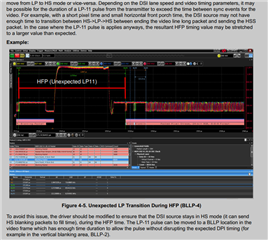Tool/software:
Hi TI:
When customers use our chip with TI941+TI948, there are a few ics jittering screen, the specific phenomenon is as follows:
screen timing: pixel clk=147.46MHz, h_act=1920, hfp=64, hbp=32, hsw=32, v_act=1080, vfp=104, vbp=6, vfp=6
dsi config: 1clock lane+4data lane, dsi clk=445MHz, data rate=890MBps
About one or two of the 1000 clients will jitter. After measuring the DSI waveform, it is found that the normal chip will enter the LP state for 12 times during one frame, and the abnormal chip will randomly enter the LP state
for 11 or 12 times. After the dsi data rate is increased to 905MBps, the abnormal IC can also be displayed normally.
Now we have the following problems to be confirmed by TI:
1: What causes the above jitter screen?
2: What is the difference when dsi enter LP state 11times or 12 times during one frame for TI941 parsing timing?
3: What are the specific requirements of TI941 for the timing of DSI? For example, what are the specific constraints on the dsi clock and timing of the screen for DSI source? How to configure it to ensure the normal display




